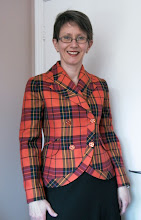Well, right after I made my second version of Vogue 1250 we departed for a week away, planned around an extended family celebration in the great urban agglomeration that vaguely surrounds the city of Toronto.
I'm happy to report that I survived the hottest July 21 on record in downtown Toronto - the actual temperature was 38C (just over 100F) and the humidex something like 51C (almost 124F). It remained hot, but thankfully not that hot, while we attended the family event and during two days spent in the delightful tiny town of Jordan, which is in the heart of the main wine-producing region of Ontario.
Since this is a sewing blog you may not care much about The Sewing Lawyer's vacation, but let me just share with you one photo, which comes close to capturing how gorgeous this wine-producing part of the country is. (What the photo misses is the country silence, the warm and pleasant breeze, and general feeling of goodwill instilled by being in good company in such a place.)
This was the view from up high on the Niagara escarpment at the lovely terrace of Vineland Estates Winery, where we enjoyed a delicious dinner.
OK, one more thing.
Excellent local wine. Ahhhh.
Enough of that.
I did have some sewing-related touristical experiences. In Toronto, I again visited Perfect Leather and bought some brick red lamb leather to make another jacket.
Toronto has realized that it ought to celebrate its different districts and there are a few pieces of public art in the area around Spadina and Queen, the heart of the garment district.
A quick internet search informed me that this was created by Stephen Cruise, and was commissioned as a result of a City of Toronto juried public art selection process. It dates to 1997 when street cars were reinstated on Spadina Avenue.
These are part of a series of sculptures at different intersections created by Randy & Berenicci. According to the City of Toronto, the pieces "represent the people and events chronicled in existing public domain images that record the changes to the neighborhood throughout this century. The structures supporting the vignettes recreate the shape of the original Hydro poles, whose function to carry and transmit power and communications is maintained in a metaphorical sense, transmitting the history of the neighborhoods. Replacing the glass insulators of the original poles, overscale cast glass birds sit on various support struts, adding an element of three dimensionality and an air of whimsy." Whew!
The fact that Hamilton Ontario also has a little garment district is less well known. It's on Ottawa Street, and I had a chance to visit en route to Jordan. My semi-planned destination was Bra-Makers Supply, renowned purveyor of all things necessary for beautiful and supportive undergarments. My visit was fast, since there was little on the premises that was of much interest to my husband. Not having enough time to consider and reconsider what I was doing (my usual shopping pattern), I bought The Book (Beverley Johnson's Bra Maker's Manual), two patterns, a bra kit (all fabric and other materials needed for one bra), two additional findings kits, some spiral steel boning, and I forget what else. Oh yeah, two pairs of foam cups. I was fitted for these by Beverley herself, with 3 students taking the intensive 2-month course preparatory to opening their own custom bra businesses looking on. Fastest fitting ever.
The artist is Daniel Davelaar and it's the result of another juried public art competition. According to this site, the sculpture is 3m (10'-0") high and "draped in cloth in such a way as to recall classical Roman and Greek sculpture. It is ... carved from a single block of Mountain Rose Granite." The dark parts are polished and the lighter drapery is left rougher so it looks completely different. I love it!
Back at home, I'm almost finished the jacket from Vogue 8718. The only thing left to do is the front fastenings. The pattern calls for 4 smallish snaps. I don't like that idea - they would be kind of ugly if the jacket is not done up, and the size Vogue wants me to use (9mm or 3/8") seem all too likely to pop open at the slightest provocation. I'm toying with the idea of using hooks on the overlap side and making thread loops (almost invisible) on the underside, but I haven't decided. The overlap is very small (about 1.5" in total or 3cm) so buttons are really out of the question. Anyone have other ideas?












